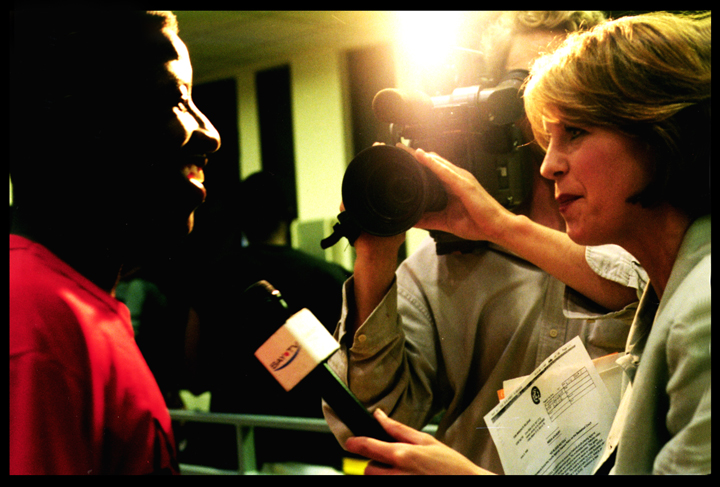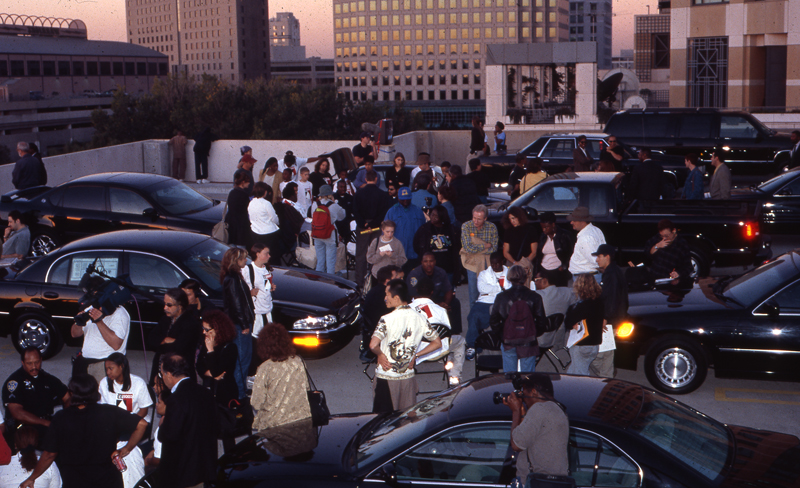The Oakland Projects (1991-2001)
A ten-year series of installations, performances and political activism with youth in Oakland, California.
Oakland, California—with its history of political activism, diversity and culture— was the site of a developing youth culture and politics in the 1990s. Between 1991-2001, Suzanne Lacy worked with scores of youth and adult collaborators to produce lengthy and large-scale public projects that included workshops and classes for youth, media intervention, and institutional program and policy development. The Oakland Projects are one of the most developed explorations of community, youth leadership, and public policy in current visual and public arts practice. The work was distributed on television, through lectures, in galleries, on documentary videos, and in articles and books.
The Oakland Projects consists of eight major works, listed below in chronological order. Please visit The Oakland Projects website for further in-depth descriptions, videos, photos, news articles, planning documents, and graphics of each work. Additionally, Suzanne Lacy's Vimeo site, contains a dedicated channel of videos documenting The Oakland Projects, including extensive behind the scenes footage, participant interviews and several broadcast news segments.
The Roof is on Fire (1993-1994)
Suzanne Lacy, Annice Jacoby, and Chris Johnson
The Roof Is On Fire featured 220 public high school students in unscripted and unedited conversations on family, sexuality, drugs, culture, education, and the future as they sat in 100 cars parked on a rooftop garage with over 1000 Oakland residents listening in. Like other productions in The Oakland Projects, this one had an extensive preparation period featuring coalition build- ing, youth development and arts education. Over the course of two years, Lacy and Chris Johnson worked weekly with teachers at Oakland Technical High School to create a media literacy curriculum on teen identity and politics and subsequently created an advanced training program for teachers from eight Oakland public high schools. Distinguished faculty including educator Herb Kohl and sociologists Todd Gitlin and Troy Duster worked with teachers to develop and apply media literacy lessons. Forty students from various schools attended bi-monthly after-school planning sessions for the performance. Students were trained in all aspects of the production and media coverage. The Roof Is On Fire was aired as a one- hour documentary by the Bay Area’s local NBC affiliate and was covered extensively on local news and national CNN. Oakland projects were distributed on television, through lectures, in galleries, on documentary videos, and in articles and books.
Participating artists include Jacques Bronson, Unique Holland and Stephanie Johnson.
Co-sponsored by The Oakland Unified School District and Oakland Sharing the Vision, Oakland, California.
Youth, Cops and Videotape (1995)
Youth involved in The Roof Is On Fire identified conflicts with police as a major concern. In the week leading up to that performance, Oakland youth were in national news as an example of out-of-control rioting in the city. While the situation was much milder than any of the earlier and later anti-racism urban insurrections, it was blown out of proportion by media. Even among officers there was a feeling that police had over-reacted. Lacy proposed a series of workshops that would address the mutual distrust between Oakland youth and officers. Lacy and collaborators from the Roof is on Fire created a series of six weekly dialogs between 18youth and 10 police officers, collaborating with Police Captain Sharon Jones and a facilitator from the U.S. Justice Department. A videotape titled Youth, Cops and Videotape was created by filmmaker Jacques Bronson and subsequently used by the Oakland Police Department for training in community policing.
No Blood/No Foul and the Oakland Youth Policy (1995-1996)
Suzanne Lacy, Annie Jacoby, and Chris Johnson
City Councilwoman Sheila Jordan initiated an Oakland youth policy with a planning team that included Lacy and youth/adult collaborators from prior projects. After focus groups and research, No Blood/No Foul was a performance that pitted youth against police officers and engaged the public in the initiative. The performance, with its live action video interrupts, pre-recorded interviews of players, half-time dance presentation, original soundtrack, and sports commentators, mixed up the rules of the game. Youth referees replaced adult referees in the second quarter, and in the third quarter there were no referees— it was street ball, where the rule is, “If there is no blood then there is no foul.” For the last quarter, the audience became the referee. Murals by local graffiti artists surrounded the court in the trendy health club, where treadmills were replaced with bleachers, youth reporters interviewed the crowd, and telephones in the lobby were connected to a hotline for audience response to the proposed Youth Policy. The performance received extensive television coverage and was attended by the may- or and city council members, who subsequently passed the Oakland Youth Policy Initiative and funded $180,000 for a youth-to-youth granting program. This yearlong project consisted of a performance, policy interventions, collaboration with city council, a media strategy, video documentary and screening, and direct services to participating youth.
Also including Unique Holland, Frank Williams, Stan Hebert, Jacques Bronson, Mike Shaw, Steve Costa, Officer Terry West, Honorable Elihu Harris Chief Joseph Samuels, Captain Sharon Jones and Greg Hodges of Urban Strategies Council. Spon- sored by the Mayor’s Office, Oakland Sharing the Vision, Oakland Police Department, Midnight Basketball and Club One at City Center as part of the Oakland Youth Policy Initiative led by Council- woman Sheila Jordan. Oakland, California.
No Blood/No Foul installation in Tokyo (1996)
Lacy installed a basketball court surrounded by graffiti murals and police/youth video interviews translated into Japanese for ATOPIC, an exhibition of conceptual and installation artists from around the world. The installation included a discussion on youth/adult conflicts led by Unique Holland with Japanese youth.
Expectations Summer Project (1997)
Suzanne Lacy, Lisa Finley, Amana Harris, Leslie Becker, Unique Holland, Annice Jacoby, Leukessia Spencer and Maxine Wyman
Expectations covered a spectrum of issues on teen pregnancy, from its personal impacts on the health and education of young women to its role in political stereotyping, law-making, and social policy. It consisted of a six-week summer school art program with high school credit, for 32 pregnant and parenting teenagers. The class focused on different themes each week, including self, relationships, health care, and public policy. The young women had on-site childcare, transportation, lunches, a stipend, and an enriched educational program with professional artists, graphic designers, and architects. All 32 young women graduated in a ceremony that included commendations from Congresswoman Barbara Lee and a speech by Superintendent of Schools Carolyn Getridge.
Sponsored by Alameda County Office of Education, Superintendent Sheila Jordan and Capp Street Galleries, San Francisco, California.
Expectations installation at Capp Street Project (1997)
Subsequently 15 young women participated in the development of an installation for Capp Street Galleries and a symposium that included pregnant and parenting youth, health care providers and politicians. Architect Finley constructed a giant crib containing a disheveled classroom with then-governor Pete Wilson delivering a speech on welfare reform castigating teen moms. Inside the classroom desks the young mothers audiotaped their responses to stereotyping and their hopes for the future. A symposium with the installation moderated by Arnold Perkins, Director of Public Health in Alameda County, featured the young mothers who were also interviewed for print and television media. A poster of their writings and drawings, designed by Leslie Becker, was sent to legislators, educators, and health care policy makers across the state.
Capp Street Project installation curated by Mary Ceruti.
Code 33: Emergency Clear the Air! (1997-1999)
Suzanne Lacy, Unique Holland, and Julio Morales
Over one hundred red, white or black cars converged on the rooftop of Oakland’s City Center West Garage. In the glow of their headlights, small group discussions between 100 police officers and 150 young people confronted urgent issues: crime, authority, power and safety. Named after the police radio code to clear the radio waves, the three-year project explored ways to reduce police hostility toward youth, provide youth with a set of skills to participate in their communities, and generate a broader understanding of youth needs. Production teams of young people produced video portraits of safety and fear in Oakland neighborhoods; these played continuously on thirty video monitors perched on the walls overlooking the city. An audience of 1000 community members roamed freely between cars, witnessing the spontaneous but carefully moderated dialogue between youth and police. After an hour of heated discussions, forty teenage dancers leapt from their groups and danced down three stories to a massive balcony where loud music and their dance performance drew the audience, the po- lice, and the youth into the final act of the performance. A police helicopter circled overhead, its spotlight further energizing the performers. On this new stage, roles were reversed—members of the former audience were now performers. Groups of people from eight different neighborhoods sat on grass-covered platforms, reminiscent of front yards, and discussed what they had heard between youth and police, while the previous “performers” listened to community residents discuss their roles in the confrontational relationship between police and youth. As with all The Oakland Projects by Lacy, a lengthy development phase provided over 350 young participants with workshops, mentorships, leadership training, paid jobs, video training, and a model youth-police series for 18 youth and 12 officers that became a curriculum for the Oakland Police. The one-hour documentary, edited by Michelle Baughan, was premiered in the City Hall Council Chambers.
With Annice Jacoby, Jacques Bronson, Raul Cabra, and Kim Baptiste. Produced with assistance from the Oakland Mayor’s Office, Oakland Police Department, Club One at City Center, and Bramalea Incorporated. Oakland, California.
Eye 2 Eye at Fremont High (2000)
While The Oakland Projects contained highly visible performances, screenings and installations, it was constituted as a weave of programs and relationships that took place throughout ten years, including projects with education, health, probation and truancy departments of the city and county, presentations at police conferences and youth career programs, curriculum design, mentorships, and on-going partnerships with significant institutions. Projects were continuously responsive to the learning in the previous ones.
After the Code 33 performance, students at Fremont High School, an overpopulated public school in the Fruitvale district, approached Lacy to request a similar performance at their school to “clear the air” between students, staff, and teachers. Eye 2 Eye was created by a team of students and consisted of a series of three facilitated conversations in May 2000 involving over 100 faculty, students, and staff. Participants were divided into small groups led by facilitators, to discuss problems and issues facing the students, teachers and the school. The first two meetings were private, held after school in the cafeteria. The goal of the final conversation on May 24, open to the public as a performance, was to come up with recommendations for action. Colorful t-shirts, banners, video monitors, and a live DJ program brought youth to the outdoor quad in the middle of the school. As each of the groups reached consensus, problems and recommendations were recorded on blackboards posted at the perimeters of the event and later presented to the OUSD Superintendent Dennis Chaconas.






































